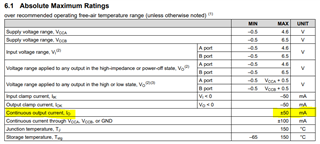Hi
I looked in the datasheet and noticed that the Vil is very low and stands for only 0.15v
Why this value is so low?
Most components specify Vol as 0.4Vmax so it doesn't comply with the TXS0102 Vil requirement
Can you explain
Regards,
Roey
This thread has been locked.
If you have a related question, please click the "Ask a related question" button in the top right corner. The newly created question will be automatically linked to this question.
Hi
I looked in the datasheet and noticed that the Vil is very low and stands for only 0.15v
Why this value is so low?
Most components specify Vol as 0.4Vmax so it doesn't comply with the TXS0102 Vil requirement
Can you explain
Regards,
Roey
Hey Roey,
The TXS0102 has a lower VIL value than other devices due to its switch/passive architecture for VIL having direct dependency to VOL. Here is more information clarifying why the VIL/VOH is more stringent than other devices.
Regards,
Jack
The information of Vil is very helpful
One more question about the one shot interface
In which phase does the one shot take action?
1. On the linear phase where vout tracks vin until the value of VCCA?
2. When the NMOS stops to conduct and only the internal P.U pulls the voltage to VCCA/VCCB?
Can you garentee that 30ns of ~3.3/50ohm =66mA will not damage the TX?
In which phase does the one shot take action?
Can you elaborate by what you mean in linear phase? More information regarding the operation of the one-shot in the TXS family can be found here (Page 4 ~5).
Can you garentee that 30ns of ~3.3/50ohm =66mA will not damage the TX?
Where are you calculating the 50 ohm? Are you attempting to calculate for Iout (the output source that flows safely into the output terminal of the device)? If so, the 66mA you are asking about will exceed the limits of Iout and potentially damage the device.

Hi
From page 15 of the datasheet about the one shot current rating
"the output resistance of the driver is decreased approximately to 50ohm to 70ohm"
If my VCC is 3.3v, what is the pulled current during the one shot phase?
If the one shot is only activated during the low to high transition then the driver is high Z so the pulled current cannot damage the component. Is it right?
My design requires I2C level translator from 1.8v to 2.5v. The TXS0102 is connected to target via 30-40cm cable (probably ~30-50pf). Should I use the TXS0102 or do you recommend on another component?
My second design required I2C translation for HDMI DDC information (translation between 5v and 1.8v and connected to target via HDMI cable). Do you recommend to use this component or another one?
Regards,
Roey
Hi,
If my VCC is 3.3v, what is the pulled current during the one shot phase?
Note that the device is passive and your output current would be based on what is driving the device. In your case, the internal 10K ohms is what would impact your output current. (VCC/10K = Iout)
If the one shot is only activated during the low to high transition then the driver is high Z so the pulled current cannot damage the component. Is it right?
Yes as it would be very low due to the output current.
My design requires I2C level translator from 1.8v to 2.5v. The TXS0102 is connected to target via 30-40cm cable (probably ~30-50pf). Should I use the TXS0102 or do you recommend on another component?
This should work as <70pF is a good recommendation. However, the cable might be too long for the auto-bidirectional signal (short traces <20cm are recommended). You can also take a look at the LSF series for I2C applications as they do not have one-shots.
My second design required I2C translation for HDMI DDC information (translation between 5v and 1.8v and connected to target via HDMI cable). Do you recommend to use this component or another one?
Both TXS and LSF are the most preferred for I2C applications, thanks.
Best Regards,
Jack.